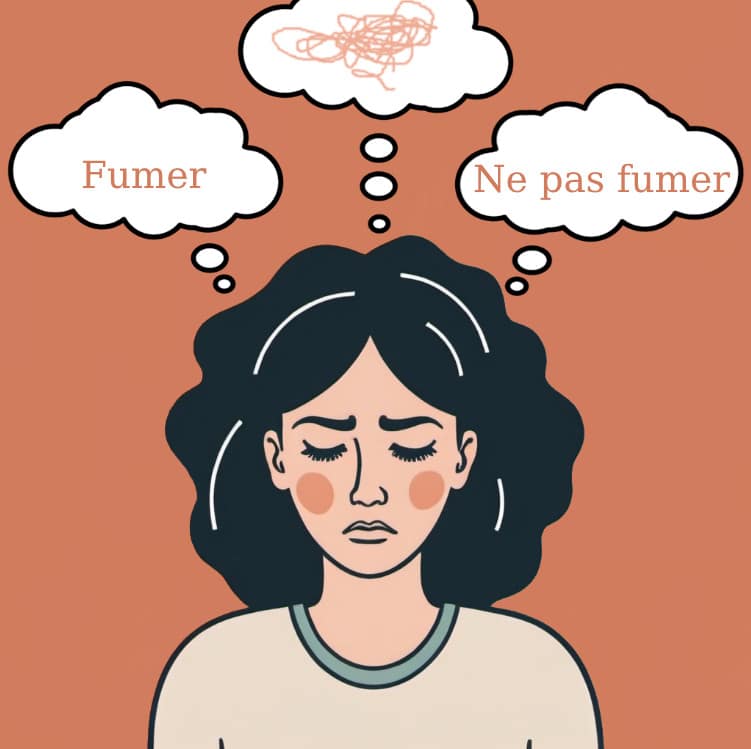Cognitive dissonance is a psychological phenomenon in which a person experiences discomfort due to the contradiction between his or her beliefs, values or attitudes and behaviors. This feeling of discomfort often leads the individual to modify one or other of these to reduce this internal imbalance.
Let’s take the example of a client who wants to be healthy, but refuses to change his lifestyle habits, such as quitting smoking. He may firmly believe that he deserves to be healthier (“I eat healthily”), while maintaining behaviors that don’t go in that direction (“I’m not athletic” or “I smoke to de-stress”). When two thoughts or actions are incompatible, we speak of a dissonant relationship. This inner tension can translate into mental discomfort, but also into physical symptoms such as muscle pain or chronic tension.
Understanding and recognizing this dynamic is essential, both for the person concerned and for the manual therapists who work with them.
| Contents How does it influence our behavior? Research | The Failure of a Prophecy How to counter cognitive dissonance? |
How does this influence our behavior?
The further one’s thinking is removed from the values that define us, the greater the sense of discomfort. The individual then seeks to resolve this contradiction. There are several ways to do this:

The theory of cognitive dissonance is based on our desire for consistency between what we say and what we do. To justify a behavior, people often avoid confronting information that could reinforce their thinking. For example, they may ignore studies on the dangers of smoking, or choose to remember only isolated examples, such as “a friend smoked for 50 years and never got cancer”. They may also tell themselves that “people get what they deserve”, thinking that “cancer only happens to other people”.
When these justification systems become entrenched, the energy expended in questioning them becomes greater than that used in ignoring new information. Instead of changing their beliefs, individuals find it easier to reject new information, seek moral support among other believers or persuade themselves that the contradiction is not real.
Research | The Failure of a Prophecy
An emblematic example is the study by Festinger and colleagues in 1956, which examined a group convinced of the imminence of the end of the world. Marion Keech claimed to have received a message from the planet Carion: aliens would arrive on Earth to save a group of believers from a massive flood due to occur on December 21, 1954. These believers had a high degree of conviction: they left their jobs, spouses, and distributed their possessions and money to prepare for their departure. But then came the fateful date and nothing happened. Their faith is directly challenged by reality. Abandoning their beliefs becomes too great an effort. Keech suddenly receives a new message stating that the God of the Earth is granting humanity a second chance because “the little group, sitting up all night, had spread so much light”.
Festinger identified five conditions that explain why some people persist in their beliefs in the face of tangible evidence that challenges them:
- Belief is deep-rooted and linked to behavior.
- The person has committed to his or her belief by taking significant action.
- The belief is precise and linked to real elements.
- Proof must be recognized as undeniable.
- The person benefits from social support, belonging to a group that shares the same beliefs.
The justifications found to reinforce the belief help reduce the anguish of challenging an established system of thought.
How to counter cognitive dissonance?
To counter cognitive dissonance, it’s essential to adopt a proactive approach, particularly in the context of a therapeutic relationship. The first step is to become aware of the dissonance and identify its sources. Let’s take the example of a client who wants to reduce stress at work, but refuses to change his work habits or situation. This type of inner conflict may not only be blocking the client’s self-fulfilment, but also expressing itself in bodily tensions, which you may perceive during a massage.
As a practitioner of manual therapy, your role is not to judge, but to create a space that invites awareness. Gently identifying these inconsistencies can help your client recognize the origin of their tension. You could, for example, use moments of exchange to ask open-ended questions: “How does your stress manifest itself in your body? What small adjustments could bring you more balance?”
By highlighting a particularly tense area related to his stress, you can get him to explore the impact of his current choices on his body and mind. The customer can then gradually align his choices with his goals. As a complement, your coaching can help him to better welcome this contradictory information and transform it into a driving force for change.
To remember:
- Humans seek above all to be in agreement with the real elements that support their beliefs and behaviours.
- Cognitive dissonance represents a contradiction between beliefs and/or actions.
- When strong beliefs are refuted by reality, the individual looks for justifications in order to be able to justify them and reduce the discomfort generated.
Source :
Festinger, L., & Schachter, S. (2013). When prophecy fails. Simon and Schuster.

